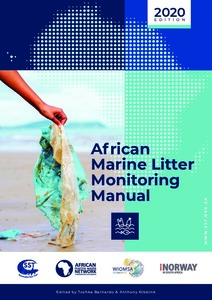Notice
This is not the latest version of this item. The latest version can be found at: https://repository.oceanbestpractices.org/handle/11329/1420.2
African Marine Litter Monitoring Manual.
| dc.contributor.editor | Barnardo, Toshka | |
| dc.contributor.editor | Ribbink, Anthony | |
| dc.date.accessioned | 2020-09-30T11:44:44Z | |
| dc.date.available | 2020-09-30T11:44:44Z | |
| dc.date.issued | 2020 | |
| dc.identifier.citation | Barnardo, T. & Ribbink, A.J. (eds) (2020) African Marine Litter Monitoring Manual. Port Elizabeth, South Africa, African Marine Waste Network, Sustainable Seas Trust, 158pp. DOI: http://dx.doi.org/10.25607/OBP-923 | en_US |
| dc.identifier.uri | http://hdl.handle.net/11329/1420 | |
| dc.identifier.uri | http://dx.doi.org/10.25607/OBP-923 | |
| dc.description.abstract | Universally, concerns are mounting over the ubiquitous increase in plastic in waterways and oceans of the world. It is commonly stated that about 80% of plastic waste enters the seas from land-based sources, of which about 90% flows down waterways to the seas. The resultant plastic pollution of the oceans is associated with serious negative environmental, ecological and economic consequences: marine life is severely affected by entanglement, ingestion and chemical pollutants; human health is also affected, and there are economic repercussions from the impacts on fisheries, shipping and tourism. Depending on local conditions, differing proportions of plastic debris end up on beaches, or sink into demersal habitats, or float off into the ocean to perhaps contribute to the oceanic gyres. The percentages given for plastics flowing to the seas from land-based sources are generalizations based on global estimates that are not necessarily supported by solid data. They are nevertheless valuable pointers indicating firstly that management of the plastic pollution of marine environments must focus on reduction at source on land and secondly that data are required to support evidenced-based strategic planning. Yet, as noted by Jambeck and her collaborators in their global analysis of 2015 and by the authors of the Africa Waste Management Outlook of 2018, data regarding plastic waste in Africa is sparse—too sparse to use as a basis for accurately understanding the current status and inadequate for strategic planning and management. This is a concern for Africa as predictions from the United Nations and World Bank are that the population growth and development of Africa over the next three decades is likely to double the amount of waste entering the environment. Clearly, the need for data regarding unmanaged plastic litter in Africa is acute. The initiation of this litter monitoring programme by the Western Indian Ocean Science Association (WIOMSA) is an essential, welcomed first step. For data to be meaningful and comparable within and across countries, they need to be gathered in consistently standard ways. This first edition of the manual has been compiled by the teams working together in Kenya, Madagascar, Mauritius, Mozambique, Seychelles, South Africa and Tanzania with a view to developing uniform ways of measurement. The African Marine Waste Network programme of Sustainable Seas Trust coordinated the manual. In this first phase of the monitoring programme, the aim is to develop uniform ways of measuring litter in rivers, estuaries, along beaches and on land. This has turned out to be more thought-provoking than originally envisaged because the need to accommodate the great variability of ecosystems and yet produce comparable data is challenging. However, the experience of those working in the field is leading to improvements based on their practical suggestions. This manual, therefore, is a growing, evolving document. This first edition is a valuable beginning. The current monitoring programme is aimed at developing reliable ways to gather data. The next steps would be to use those data for management. Once data are collected in a reliable uniform manner, they contribute to baselines. Provided such baselines are sensitive enough to be able to detect impacts of interventions and robust enough to support strategic planning and predictive modelling, they become powerful measures of success, indicators of where and what types of intervention are required and what adaptions are required to manage new developments. Although measuring the litter does not make it more manageable per se, the derived data can give valuable clues, on which decisions can be made and actions planned. The WIOMSA monitoring programme and this manual are aimed at providing the tools to measure plastic waste, ultimately to set baselines against which change can be measured, and to provide the measurable foundation for management of plastic and other waste. | en_US |
| dc.description.sponsorship | Ministry of Foreign Affairs, Norway Western Indian Ocean Marine Science Association (WIOMSA) | en_US |
| dc.language.iso | en | en_US |
| dc.publisher | African Marine Waste Network, Sustainable Seas Trust | en_US |
| dc.rights | Attribution-NonCommercial-NoDerivatives 4.0 International | * |
| dc.rights.uri | http://creativecommons.org/licenses/by-nc-nd/4.0/ | * |
| dc.subject.other | Litter Monitoring | en_US |
| dc.subject.other | Marine plastics | en_US |
| dc.subject.other | Marine litter | en_US |
| dc.subject.other | Marine debris | en_US |
| dc.subject.other | Marine pollution | en_US |
| dc.title | African Marine Litter Monitoring Manual. | en_US |
| dc.type | Report | en_US |
| dc.description.status | Published | en_US |
| dc.format.pages | 158pp. | en_US |
| dc.publisher.place | Port Elizabeth, South Africa | en_US |
| dc.subject.parameterDiscipline | Parameter Discipline::Environment | en_US |
| dc.subject.dmProcesses | Data Management Practices::Data acquisition | en_US |
| dc.description.currentstatus | Superseded | en_US |
| dc.description.sdg | 14.1 | en_US |
| dc.description.sdg | 14.2 | |
| dc.description.maturitylevel | TRL 7 System prototyping demonstration in an operational environment (ground or space) | en_US |
| dc.description.bptype | Manual (incl. handbook, guide, cookbook etc) | en_US |
| obps.contact.contactname | Toshka Barnardo | |
| obps.contact.contactemail | toshka@sstafrica.org.za | |
| obps.resourceurl.publisher | https://sst.org.za/wp-content/uploads/2020/07/Barnardo-Ribbink-2020_African-Marine-Litter-Monitoring-Manual.pdf | en_US |
 Repository of community practices in Ocean Research, Applications and Data/Information Management
Repository of community practices in Ocean Research, Applications and Data/Information Management

